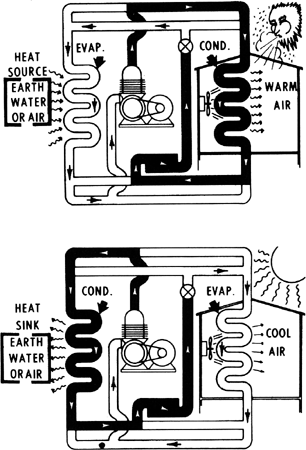heat pump
[′hēt ‚pəmp]Heat pump
Heat pump
The thermodynamic counterpart of the heat engine. A heat pump raises the temperature level of heat by means of work input. In its usual form a compressor takes refrigerant vapor from a low-pressure, low-temperature evaporator and delivers it at high pressure and temperature to a condenser (see illustration). The pump cycle is identical with the customary vapor-compression refrigeration system. See Refrigeration cycle
This dual purpose is accomplished, in effect, by placing the low-temperature evaporator in the conditioned space during the summer and the high-temperature condenser in the same space during the winter. Thus, if 70°F (21°C) is to be maintained in the conditioned space regardless of the season, this would be the theoretical temperature of the evaporating coil in summer and of the condensing coil in winter. The actual temperatures on the refrigerant side of these coils would need to be below 70°F in summer and above 70°F in winter to permit the necessary transfer of heat through the coil surfaces. If the average outside temperatures are 100°F (38°C) in summer and 40°F (40°C) in winter, the heat pump serves to raise or lower the temperature 30° (17°C) and to deliver the heat or cold as required.
The heat pump is also used for a wide assortment of industrial and process applications such as low-temperature heating, evaporation, concentration, and distillation.
heat pump

Heat Pump
a device that transfers thermal energy from a lowtemperature heat source, most often the environment, to a high-temperature heat receiver. The operation of a heat pump requires the consumption of external mechanical, electrical, chemical, or other type of energy. The processes that occur in a heat pump are similar to those involving the working fluid of a refrigerator, except that refrigeration equipment is designed to generate cold, whereas a heat pump generates heat. Liquids with a low boiling point, such as Freon or ammonia, are the working fluids normally used in a heat pump.
The heat flowing into the receiver of a heat pump consists not only of a quantity equivalent to the external work performed but also heat from a heat source, such as river water. Consequently, the energy conversion factor for a heat pump is always greater than 1, and the conversion process is more favorable than the direct conversion of electrical, mechanical, or chemical energy into heat. However, the trend in power engineering toward joint production of heat and electric power limits the use of heat pumps to situations in which other forms of thermal energy cannot be readily supplied—for example, in locations far from district heat and power plants.
Heat pumps are sometimes used for heating buildings in regions with warm climates, since the same unit may be using during the summer to cool incoming air. Because of fuel shortages, heat pumps were widely used during World War II (1939–45), particularly in countries that had a surplus of cheap hydroelectric power, such as Switzerland, Sweden, and Norway.
V. S. BUNIN